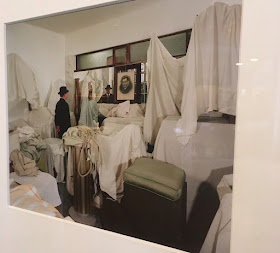In this review, I will focus on how portrait
photography was presented in the exhibition Beyond
the Mirror currently held at Calouste Gulbenkian Museum in Lisbon. The
theme of the exhibition is borrowed from Lewis Carrol’s novel Through the Looking-Glass, and What Alice
Found There (1871); and it evokes the whimsical aspect of experiencing a
direct reflection of reality. Curated by Maria Rosa Figueiredo in collaboration
with Leonor Nazaré, the exhibition maps how the mirror has been historically
involved with the European realm of artistic representations. Between
surrealism and allegoric narratives, the photographs of Paulo Mendes, Jorge
Molder, Richard Hamilton, Daniel Blaufuks, Noé Sendas, Cecília Costa, Ana
Janeiro and Michelangelo Pistoletto are placed side by side with paintings and
sculptures that evoke the long-standing problem of understanding self-identity.
In the core of this matter there is a fundamental quest for truth, that
confronts the unsettling and mysterious reality created by the playful
inclusion of the mirror in their photographs. This ambivalence suspends the
mirror as an object of coherent vision of the world, and transport the viewer to
a dream-like space welcoming the projection of desires. The common point
between the reflected world of the mirror and the one captured by the
photograph, is the possibility of finding something unique about the self, and
how this uniqueness is perceived socially.
Daniel Blaufuks (1963) Hand with Mirror from the series Oficio de Viver, 2010. Inkjet Print.
Blaufuks photograph illustrates the idea of identity
as something precious and private, that could be kept hidden from others or set
to complete disappearance. In this last reading, the hand as a background could
suggest the “let go” of the reflected face. The dramatic lighting enhances the
textures of the hand whose strong lines alludes to past experiences. The hand
reminds the viewer that there are some physical and psychological aspects of
the self that become more prominent through
time, while others are ephemeral.
Ana Janeiro
(1978) Onze#13, 2004. Chromogenic
print.
Cecília Costa
(1971), Isabel, from the series tiled
Pli ,2005. Lightjet Print.
In Janeiro’s Photograph, there is a clash between the
subject and its unrecognized reflection. The double acquires an autonomy that
is not welcomed by its original, and becomes a threat. Similarly, in Costa’s
image, the subject turns into anonymity by getting too close to herself. A
confusion that unexpectedly created by blending the delineation of object with
that of its subject.
Cecília Costa (1971) Notting Hill II, from the series
Pli ,2006 Lightjet Print.
Paulo Mendes (1966) O Senhor S – aceita o seu destino, como um santo se sacrifice, tenta
controlar os impulsos mais obscuros e congénitos da sua existêcia interior,
from the series S de Saudade.
2008-2009. Inkjet Print.
It becomes inevitable to metaphorically leave your own
body in order to analyze who we really are. The reflected image acquires the
status of an entity, a double extension of the self turning the mirror into an allegorical object, responsible for
psychological knowledge as well as the construction of subjectivity. In Mendes
photograph, this entity assumes the form of nostalgia. The phantasmagoric
scenario of hidden objects intensifies the relation of subject and his image
that is mediated temporally by the pictures of Salazar hanging on the wall.
Noé Sendas (1972) Crystal
Girl no. 78 and 69, 2012 (Ed.
AP1) inkjet prints.
Jorge Molder (1947) Retrato, série Nox, 1999,
Silver Gelatin Print
Furthermore, the promise of knowledge about the self is turned into a trap. The
embodiment of a narcissistic illusion is what causes in us an unsettling
sensation when searching for a dialogue with the mirror. So fascinating to
eyes, this experience deviates us from the truth, and it allows access to an
infinite world of imagined dimensions and vices related to beauty.
Richard Hamilton
(2922-2011), Mirror Image, 1974, Collotype.
Michelangelo Pistoletto (1933), due ragazzi alla fonte
1975. Photography on mirror.
Throughout the exhibition, the mimetic aspect of the
photographic medium overlaps the dualistic instance of the mirrored image, and
reaches its epiphany with the work of Pistoletto, who reminds us of the uncanny
relation that could exist between stable bi-dimensionality of the photograph
with the tri-dimensional depth of the reflected image. His work is conceptually linked with that of
Richard Hamilton as it pinpoints that the mirror image is an ephemeral passage
while the photograph is a solid and retained image. Overall, the photographs in
the exhibition address a symmetrical balance between the power of reflected image
and our willingness to shape a truthful aspect for the self, which demands us seen beyond what you expect in this introspective
instance.








